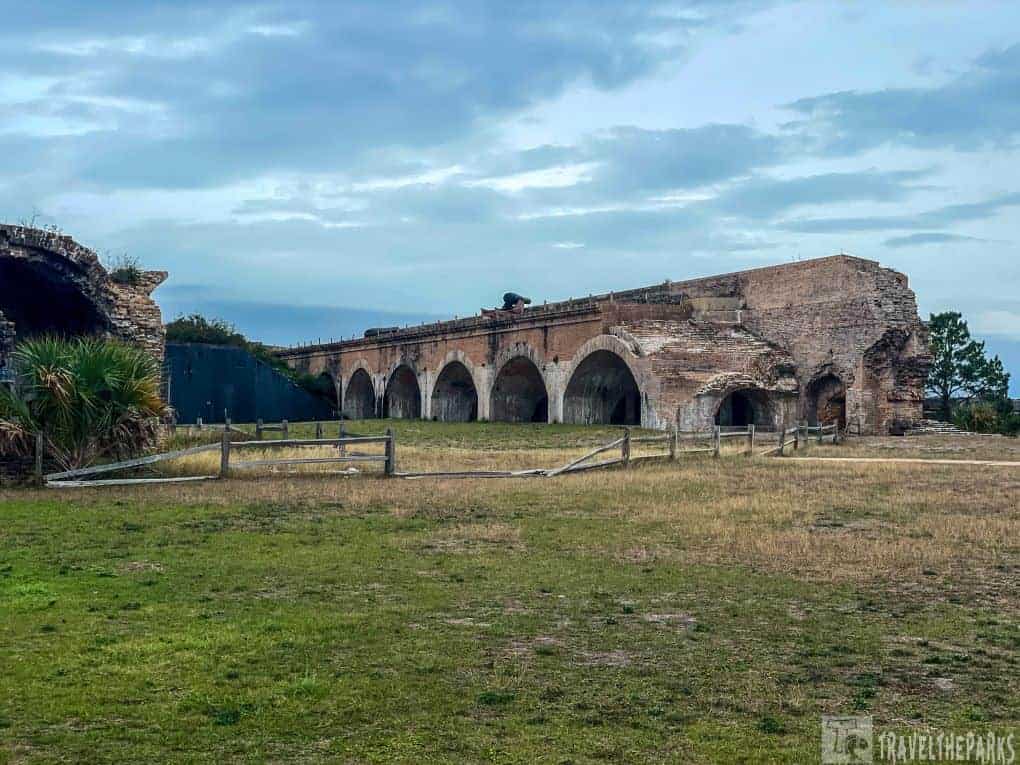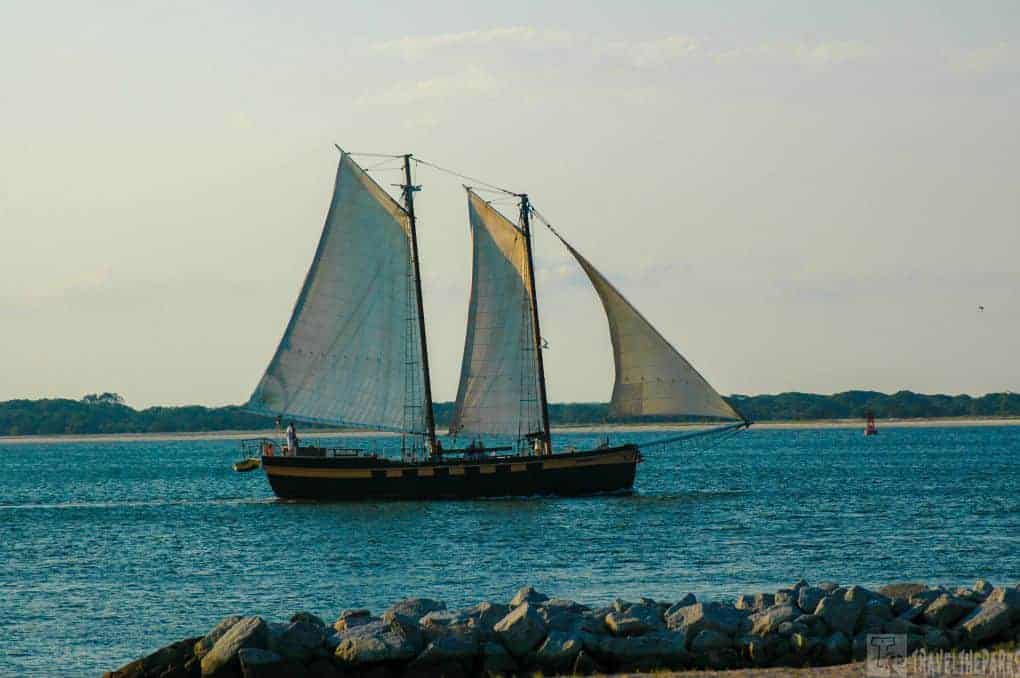In the Gulf Islands National Seashore, we discovered the secrets of Fort Pickens. It’s a Civil War site near Pensacola Beach. Here we explored hidden passageways, getting a glimpse into a bygone era. Climbing the breathtaking cannon batteries, we founded stories etched in every brick. This fort has a fascinating military history, not to mention the incredible natural scenery. Come with us as we embark on an adventure you’ll never forget.
This post may contain affiliate links, meaning if you purchase something through one of these links, we may earn a small commission at no extra cost to you! Read the full disclosure policy here.
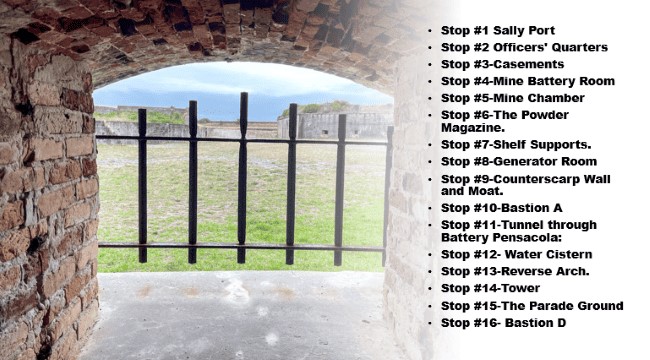
Like many mid-19th century forts in the United States, Fort Pickens belongs to the Third System of Fortifications. This system emphasized brick and masonry construction over older earthen designs, making them more resistant to cannon fire. You can see the sturdy brick walls and bastions of Fort Pickens, similar to those found in Fort Jefferson in Dry Tortugas National Park or Fort Pulaski near Savannah.
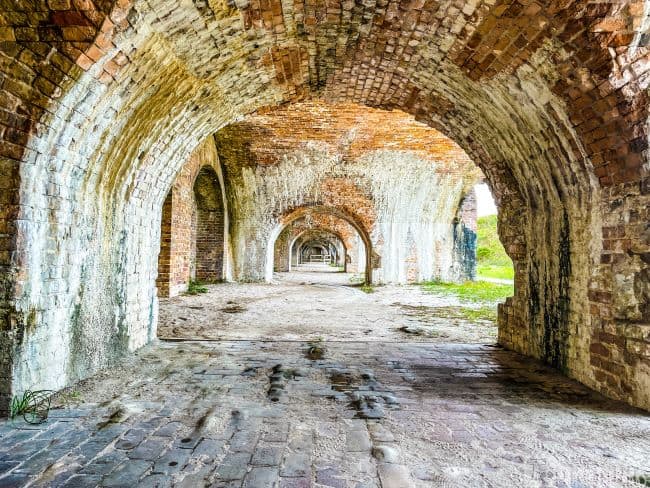
Table of Contents
Fort Pickens Adventure Awaits: Travel Tips and Transportation Options
Getting to Fort Pickens in Pensacola can be done in various ways, depending on your preferences and budget. As part of our Texas/New Mexico road-trip, we arrived by passenger vehicle towing our travel trailer. This was the most convenient option. Take Exit 12 off Interstate 10 for I-110 South, then continue onto Exit 1A-1B towards Gregory St/US-98/Beaches/Gulf Breeze/Gulf Islands National Seashore. Follow signs for Pensacola Beach Rd and then turn right onto Fort Pickens road.
Note: Do not take 17th street railroad bridge known as the Graffiti bridge, only has 10 foot clearance. We cleared it, but just barely.
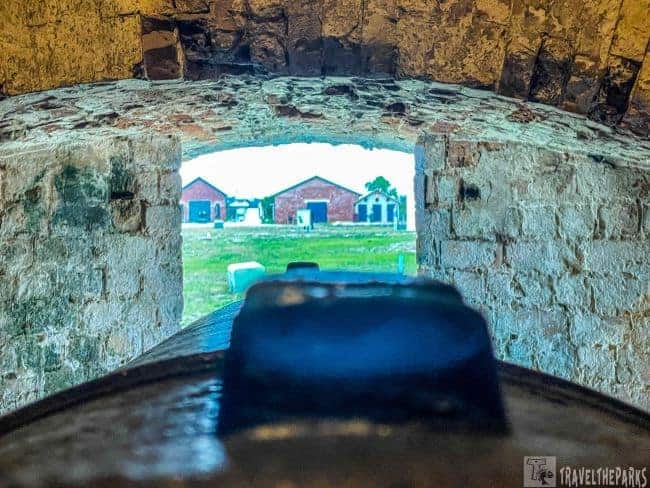
If time permits, take the ferry just for the scenery. The Pensacola Bay City Ferry from the historic waterfront in downtown Pensacola to the Fort Pickens Ferry Plaza. The ferry runs seasonally, typically from March to October. There is also a Gulf Islands National Seashore tram. Once you arrive at the Fort Pickens Ferry Plaza, you can take the free Fort Pickens Tram to various points within the area, including the Fort, Langdon Beach, and the campground. In season, the tram operates on the same schedule as the ferry boats.
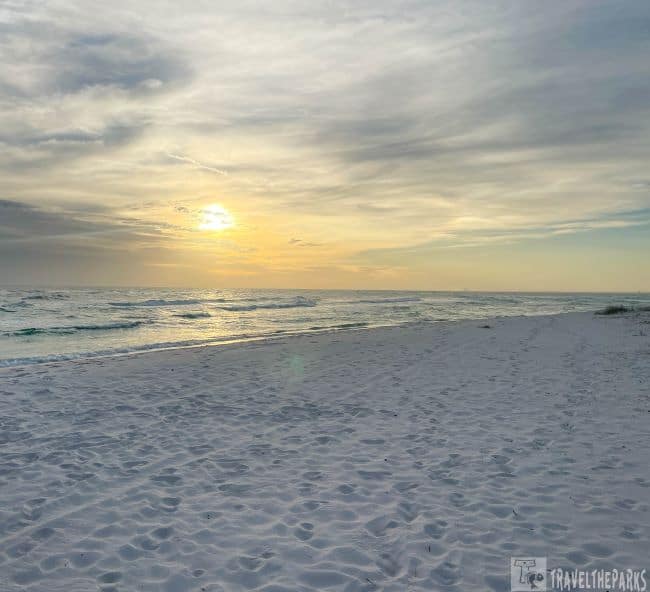
Fort Pickens Must-Knows: Maximize Your Trip
- We noted that there was ample parking available at the Fort Pickens area. Be aware that parking fills up quickly on weekends and holidays, so arrive early or consider alternative transportation options.
- There is an entrance fee to access the Fort Pickens area. You can purchase a pass at the entrance station (credit card only) or online in advance.
- Consider purchasing an interagency annual pass if you plan on visiting other National Park Units during your trip.
- The Fort Pickens tram and some areas of the park are accessible for people with disabilities. However, the fort itself has uneven terrain and may be difficult to navigate for some.
- Pets are not allowed on the ferry or within the Fort Pickens area, except for service animals.
- We noticed that during the off season (November-February) some services and amenities may be limited.
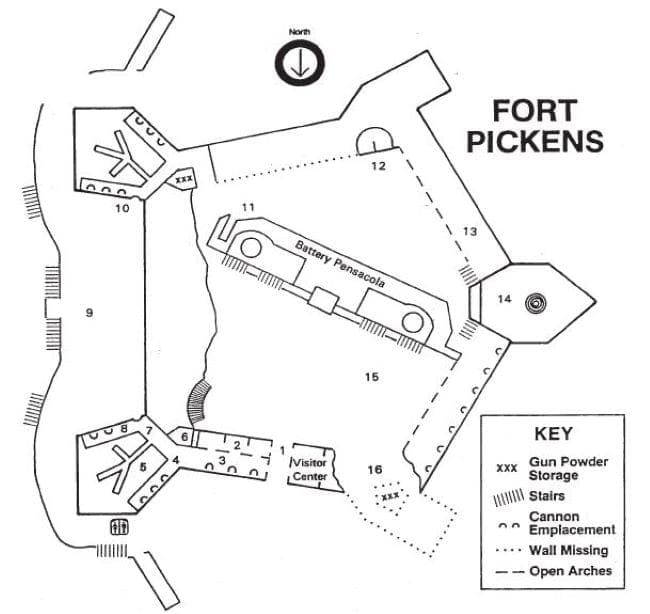
A leisurely self-guided tour is the best way to learn about the fort and its many features. Download the Fort Pickens Self-guided Tour brochure: http://npshistory.com/brochures/guis/fort-pickens.pdf or use the NPS app to get started. We begin our tour at the Main Gate, a defensive gate designed to protect the fort. The tour includes sixteen stops. They number each stop and include placards providing greater detail. Throughout the tour, we learned about the fort’s important history, its role in various conflicts, and the daily life of soldiers who served there.
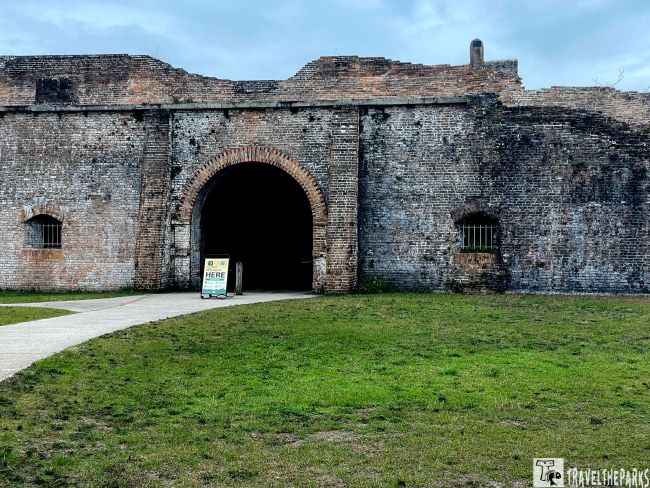
Stop #1-Sally Port-Complete Self-Guided Tour Fort Pickens
This was the main access corridor to the fort. They secured it with heavy oak doors. Soldiers used it to exit and enter the fort. At one point, the rail tracks that ran from Battery Pensacola passed through the sallyport. On the right is the visitor’s center. We turned left, moving to Stop #2.
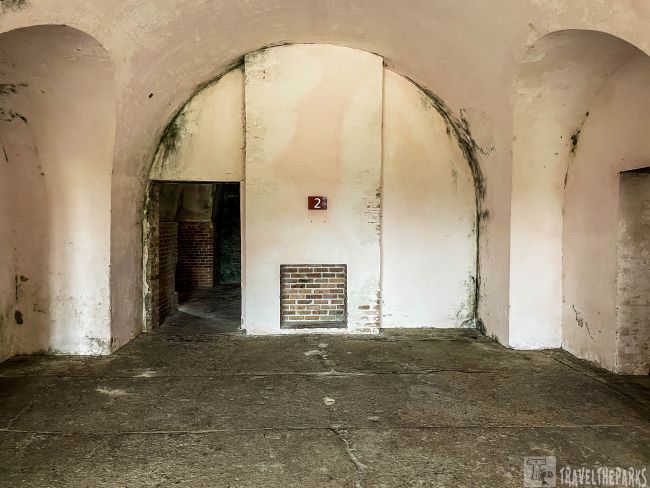
Stop #2 Officers’ Quarters-Complete Self-Guided Tour Fort Pickens
: Stepping into the restored Officer’s Quarters, the plaster-lined rooms were intended for officers and their families. First thing we noticed was the original wood flooring, brick fireplaces, and the impressive size of the building. The Soldier Barracks are also here in a large building used to house soldiers.
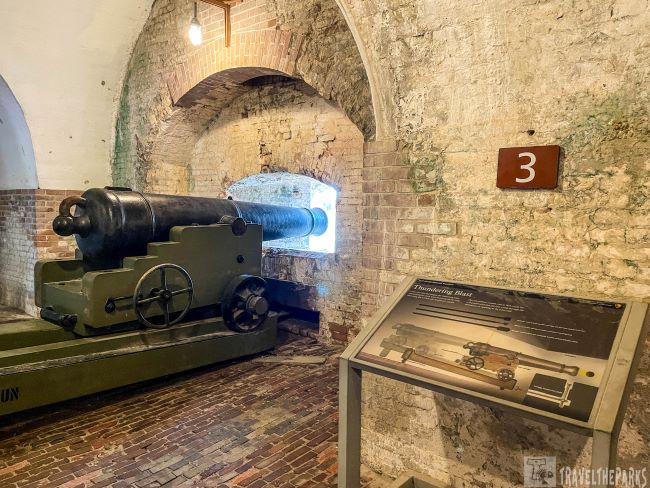
Stop #3-Casements-Complete Self-Guided Tour Fort Pickens
As the morning sun climbed higher, so did the temperature. Seeking relief from the blazing Florida heat, we found sanctuary in the casements. These brick-vaulted chambers worked like magic, bringing the temperature down dramatically. Casements, more than just storage spaces, had a range of uses. These tunnels were versatile, serving purposes like storing cannons, ammunition, and even providing shelter for soldiers. In these refreshing casemates, frozen in time since the 1800s, it felt almost natural to envision sturdy soldiers swapping stories and sharing laughter after a day packed with drills.
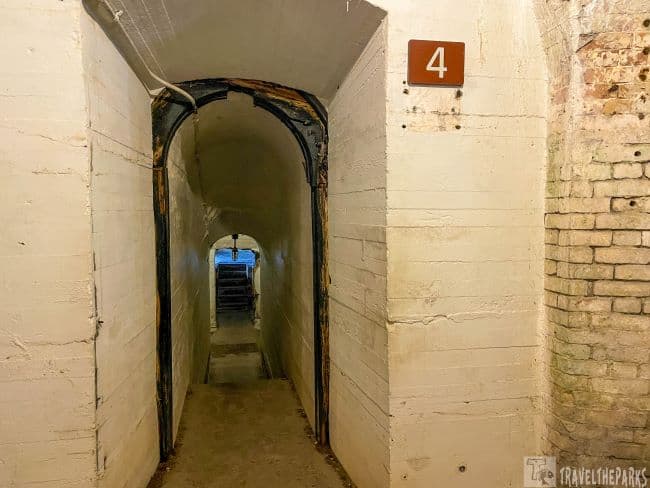
Stop #4-Mine Battery Room: Inside this room the light was dim. The only sounds we heard were the whispers of history and the occasional drip of water. These batteries powered minefields in the harbor in 1894. In 1904, floods forced the move to an outside building. It was mistakenly called Geronimo’s cell for years.
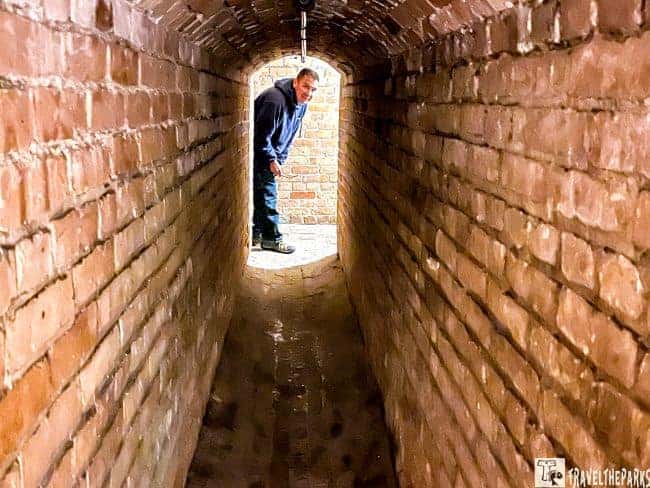
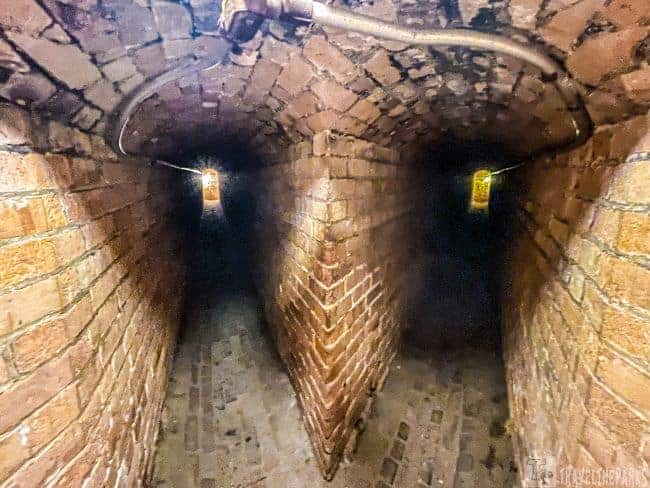
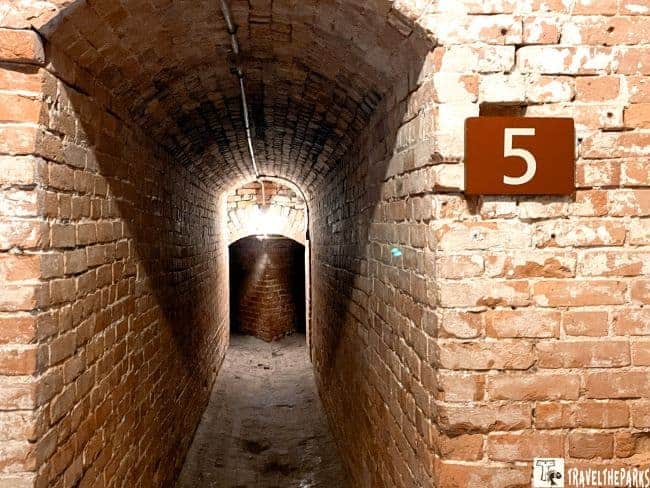
Stop #5-Mine Chambers: We descended into the cool, dark tunnels beneath the fort. These were used to defend the fort. If the enemy breached the forty, soldiers would blow these tunnels caving in the fort walls. Of course, this was a last resort. The tunnels lead to three rooms, giving the fort a gunpowder capacity of over 1,000 pound.

Stop #6 the Powder Magazine-Complete Self-Guided Tour Fort Pickens
Even though it’s not holding any explosive stuff anymore, the Powder Magazine is like a quiet observer of Fort Pickens’ history. It’s a constant reminder of how firepower was crucial for defending forts and how it played a huge role in keeping the fort always ready for action. This tough structure is no joke – thick brick walls, a vaulted brick ceiling – all built to take on cannon fire and potential explosions. They even lined it with wood to keep the powder dry and used copper and brass hardware to keep sparks away.
Standing in there, it’s almost like you can hear the whispers of history. Picture soldiers handling the gunpowder, getting it ready for action, fully aware that the fate of the fort relied on their attention to detail. It’s like stepping back in time, right inside the Powder Magazine.
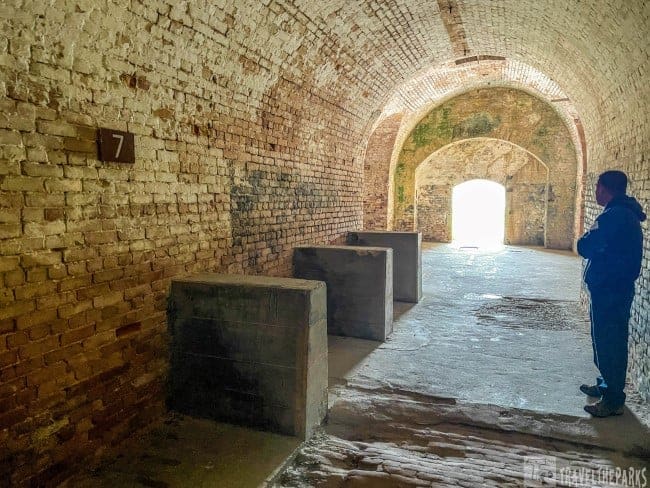
Stop #7–Shelf Supports: just around the corner. Feel the weight of history as you walk through these passageways.
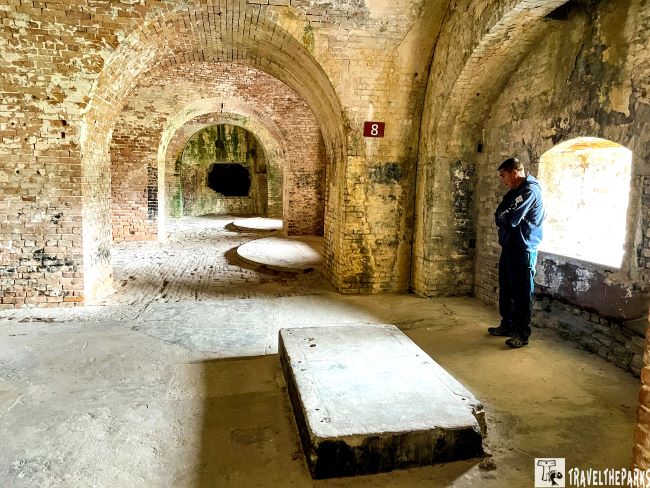
Stop #8-Generator Room-Complete Self-Guided Tour Fort Pickens
As we continued our exploration of Fort Pickens, we came across the Generator Room. It seemed like a quiet relic. This unassuming structure played a crucial role in the fort’s modernization and defense capabilities in the early 20th century. The original purpose of these three casemates was to hold cannons. However, in 1903, engineers converted them into a central power station. This marked a significant shift in the fort’s operation, replacing reliance on labor with the efficiency of gas-powered generators. Imagine the bustling activity that once took place here, with engineers tending to the generators and ensuring the smooth flow of electricity throughout the fort.
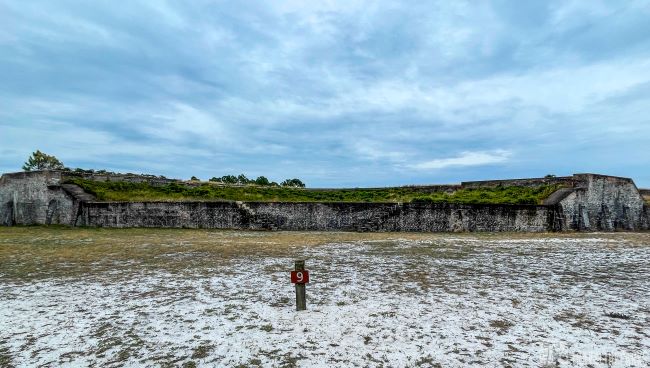
Stop #9-Counterscarp Wall and Moat-Complete Self-Guided Tour Fort Pickens
Teaming up, the counterscarp wall and its buddies played a key role in safeguarding the fort from enemy onslaughts. Picture this – standing on the counterscarp wall, you feel like you’re one of those soldiers standing guard, strong and resolute. The counterscarp wall, standing tall and bold, was like the fort’s ultimate defense line. They built these tough walls with bricks and granite, absorbing cannon hits like a boss to keep those foes at bay. And hey, they even filled up the moat with water, making it a real headache for any wannabe attackers trying to get across.
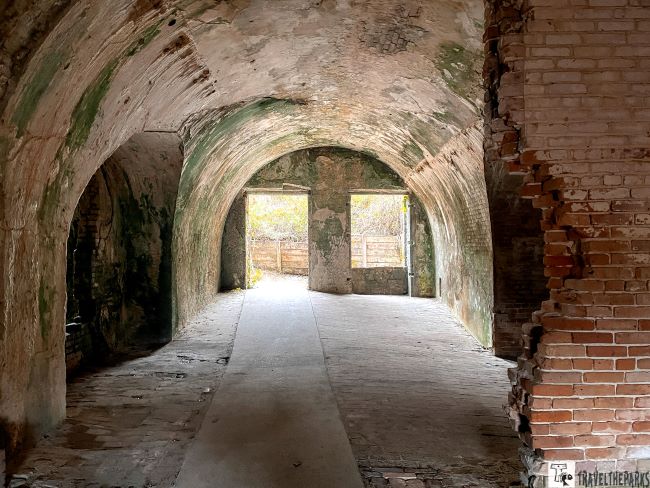
Stop 10-Bastion A-Complete Self-Guided Tour Fort Pickens
In these fort bastions, there’s this tall sentinel–a pentagonal structure that sticks out from the fort’s main wall. When you climb up the bastion’s walls, it’s like you can almost sense the spirits of soldiers from way back when walking the walls and keeping a watchful eye on the horizon for any possible dangers.
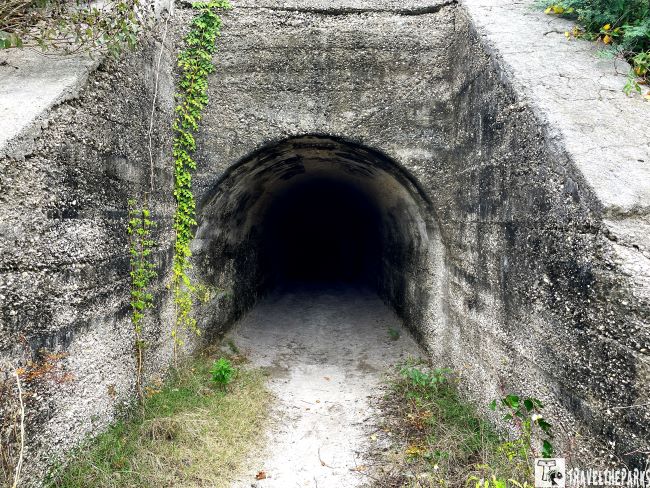
Stop 11-Tunnel through Battery Pensacola-Complete Self-Guided Tour Fort Pickens
As we approached the north entrance, we saw a bricked-up opening with an interpretive sign providing information about the tunnel’s history and purpose. Constructed in 1898, it was built to connect the newly constructed Battery Pensacola on the parade ground with the warehouse areas on the south side of Fort Pickens. Unfortunately, the tunnel met a premature end in 1922. A warehouse collapse near the south entrance blocked the passage, rendering it unusable.
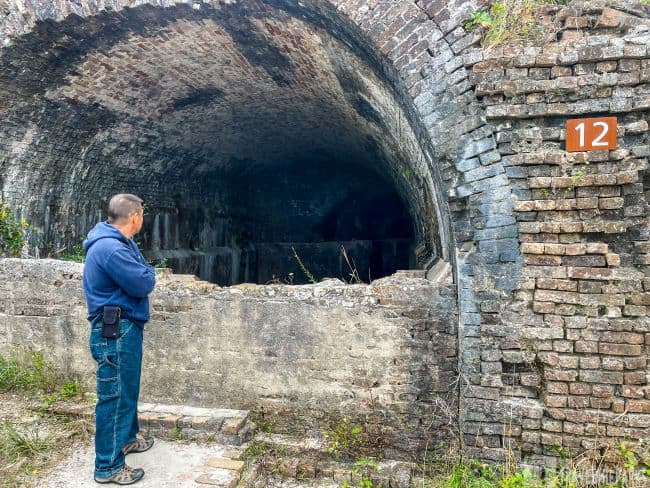
Stop #12-Water Cisterns-Complete Self-Guided Tour Fort Pickens
All the forts we have visited have had cisterns for water. Most of the Third System of Fortifications are located adjacent to saltwater. A source of freshwater was a dire need for functionality. These two massive brick-lined basins were built in 1839. Like most of the fort’s itself, these were built using slave labor. The engineers used an ingenious way to collect rainwater. It was channeled from roofs throughout the fort. They could hold a staggering 193,392 gallons of water. That’s was enough to sustain around 1,200 soldiers for up to 161 days.
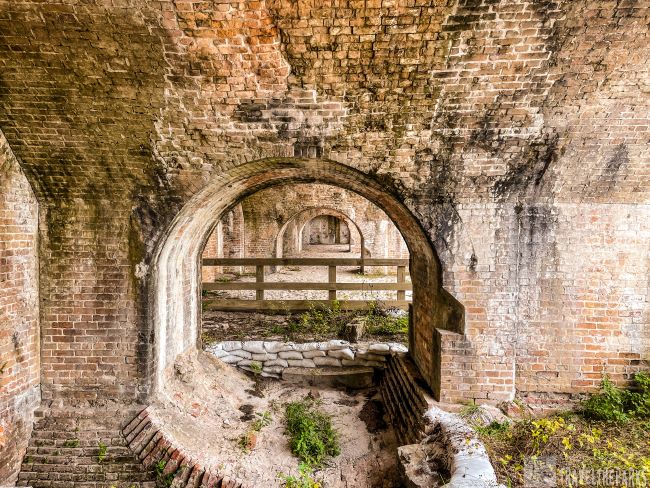
Stop #13-Reverse Arch-Complete Self-Guided Tour Fort Pickens
Hidden from view, reverse arches were crucial to the fort’s stability. The interpretive sign at the stop unveils this concealed infrastructure of wooden beams and reverse brick arches. They are designed to counter this pressure, spreading the weight outwards and downwards towards the piers below. Think of them as an upside-down arch, effectively pushing back against the downward force to prevent the walls from collapsing.
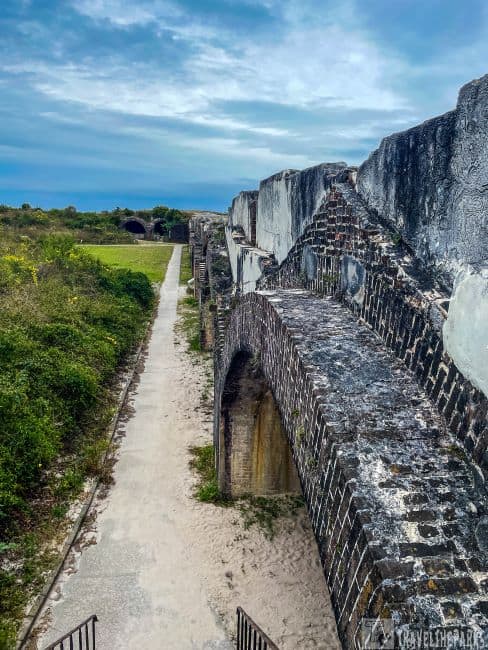
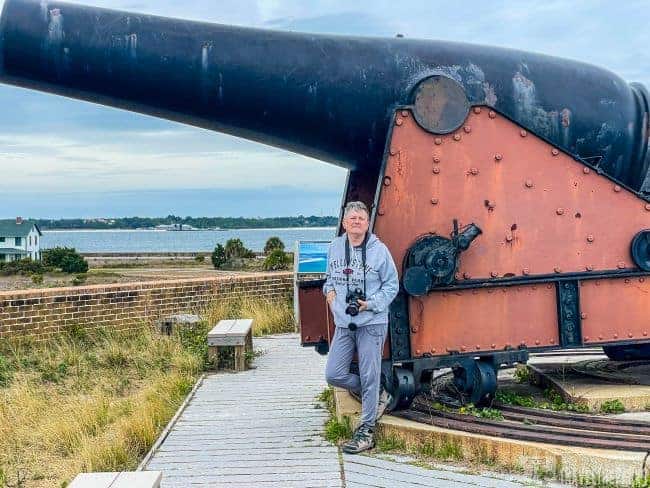
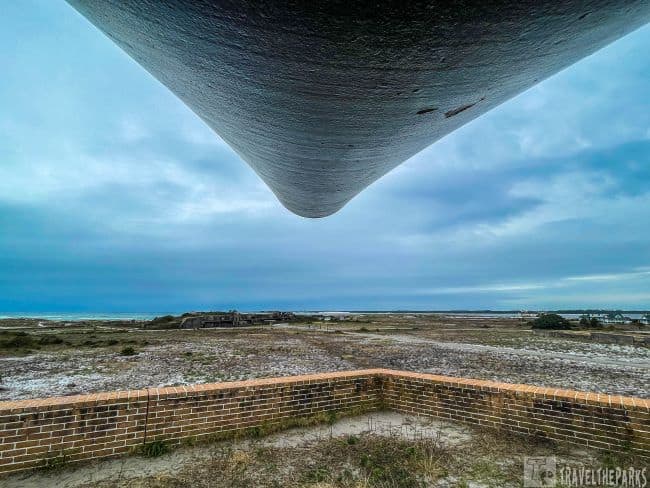
Tower Stop14-Battery Pensacola Wall-Complete Self-Guided Tour Fort Pickens
We climbed the stairs to the top of the tower wall only to find spectacular 360-degree views of the cityscape on Pensacola bay and the beachside. At the top, we spotted a behemoth 15-inch Rodman gun, a formidable relic of the fort’s artillery. This cannon could fire a 450-pound solid shot up to five miles, serving as a powerful deterrent to invading ships.
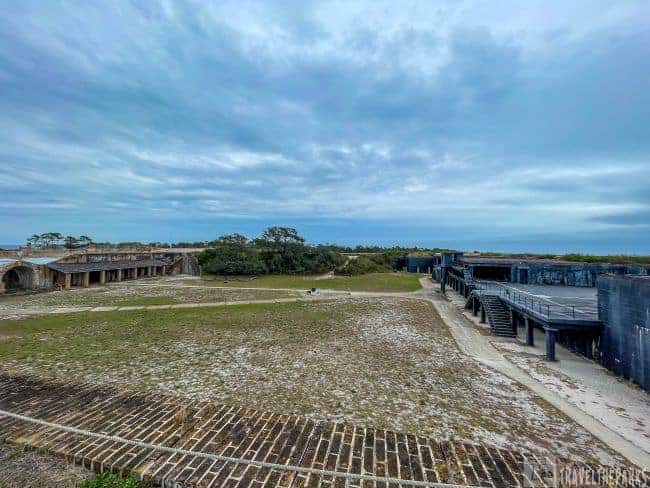
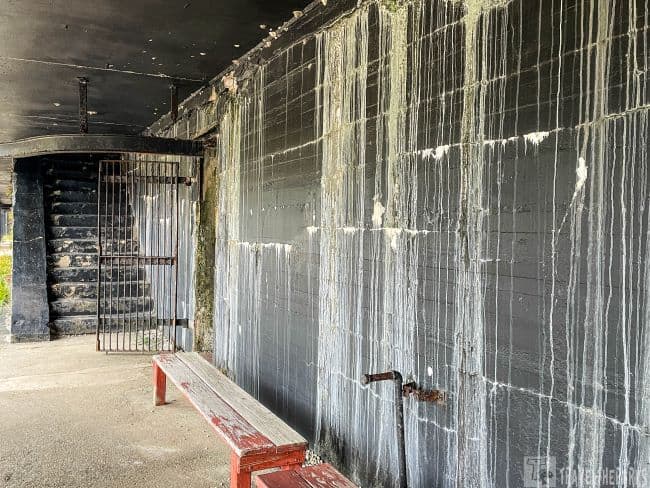
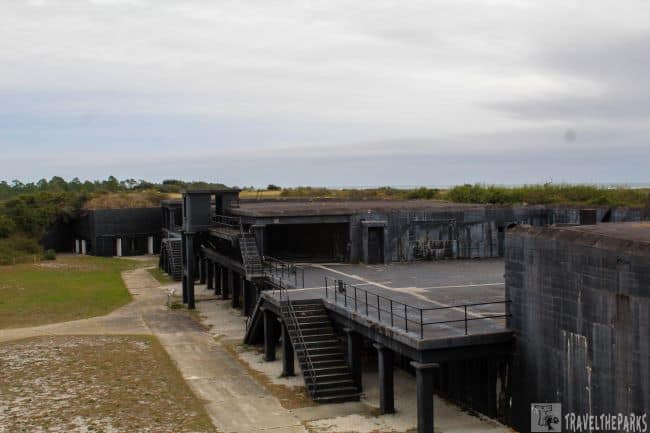
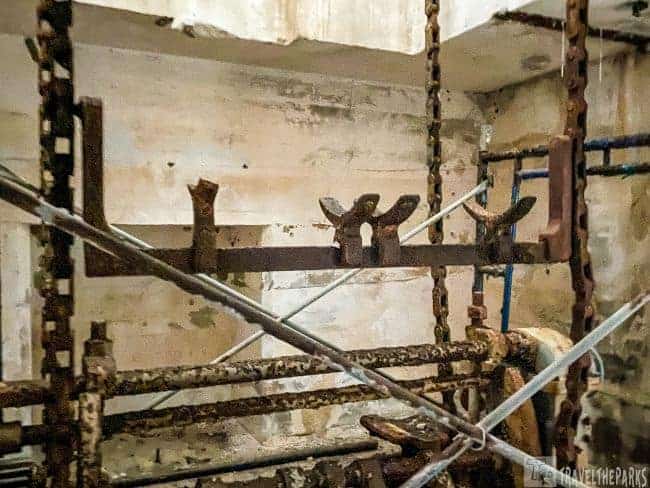
Looking down, we could see the ominous black silhouette of Battery Pensacola. The fort’s imposing structure can inspire a sense of awe and perhaps even trepidation. This battery was added in 1898, much later in the forts history. We explored the lower levels, peering at the remnants of ammunition magazines and crew quarters. You could see the carriages in which the munitions were transported to the upper bastion. The cutting-edge military technology of its time it housed disappearing gun carriages and two massive 12-inch rifles capable of firing shells nearly seven miles.
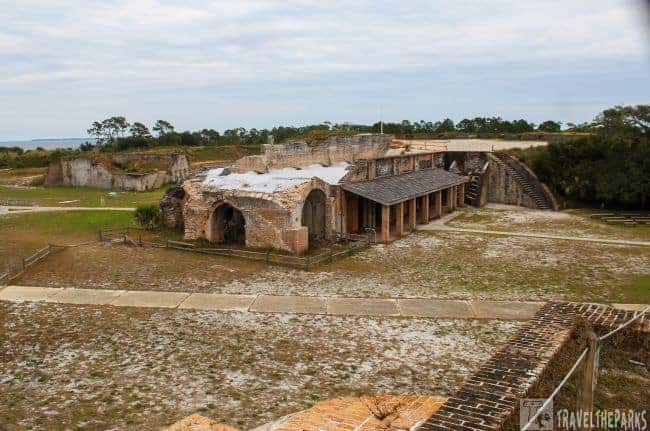
Stop #15 Parade Ground-Complete Self-Guided Tour Fort Pickens
The Parade Ground, a large open green space in the heart of the fort. This was the central gathering place for the fort’s soldiers. It was the stage where soldiers drilled, ceremonies unfolded, and military life hummed with activity. Walking the parade ground, we didn’t just see the parade ground as a space for military displays. It was not too difficult to imagine families gathering for picnics, children playing amidst the drills, and moments of respite from the rigors of military life.

Stop #16 -Bastion D-Complete Self-Guided Tour Fort Pickens
Bastion D was built in 1834 and finished in 1844. With 24-pound cannons, the bastion could fire 360 degrees. Currently, all that remains of the magazine are its skeletal ruins. These remind us of the dangers soldiers faced at Fort Pickens. The bastion caught fire in 1899, and it spread to the magazine. Igniting a bunch of black powder. As a result, the magazine and much of the bastion walls were destroyed. The debris flew miles inland. Two soldiers were also killed and several others were injured in the explosion.
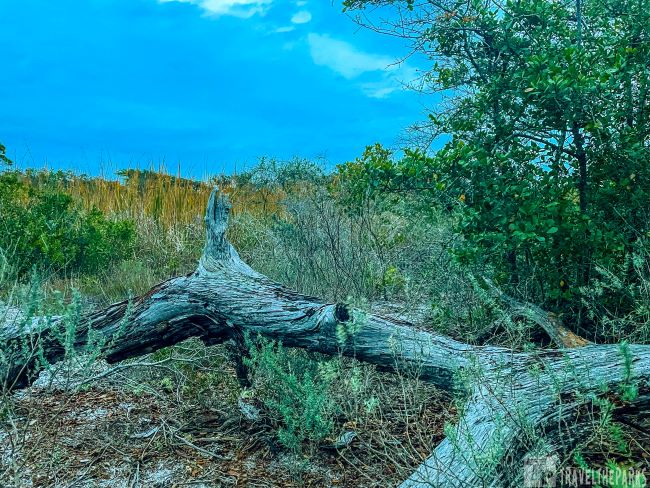
Here are some additional tips for doing a self-guided tour of Fort Pickens:
- Wear comfortable shoes, as you’ll be doing a lot of walking.
- Bring water and sunscreen, especially if you’re visiting during the summer months.
- Be sure to read the signs at each stop on the tour to learn about the history of the fort.
- Take your time to be in the moment and enjoy the scenery. Fort Pickens is a beautiful place, and there’s a lot to see.

Exploring the Many Batteries of Fort Pickens in the Gulf Islands
What makes Fort Pickens truly fascinating is the interconnected network of batteries, each complementing the other in a cohesive defensive strategy. It takes the better part of a day to tour all the batteries within the park. We started with Battery Turman and Payne. These defenses provided a 360 degree protection of the inlet to the bayside. Fortified by the use of mines strategically placed within the inlet to protect against torpedo boats.
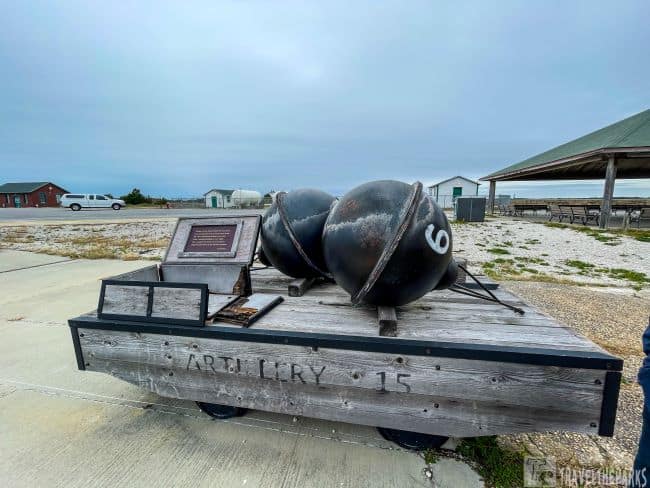
The Endicott series built between 1895 and 1899, these batteries were part of a nationwide initiative (1885-1905). Fort Pickens received four Endicott Batteries: Cullum-Sevier (4x 10-inch guns), Pensacola (2x 12-inch guns), and Worth (2x 6-inch guns). These batteries replaced the older, masonry-style forts with dispersed concrete emplacements housing powerful disappearing guns. Studying the Endicott Batteries at Fort Pickens provided us with valuable insights into the evolution of American military technology and defense strategies.
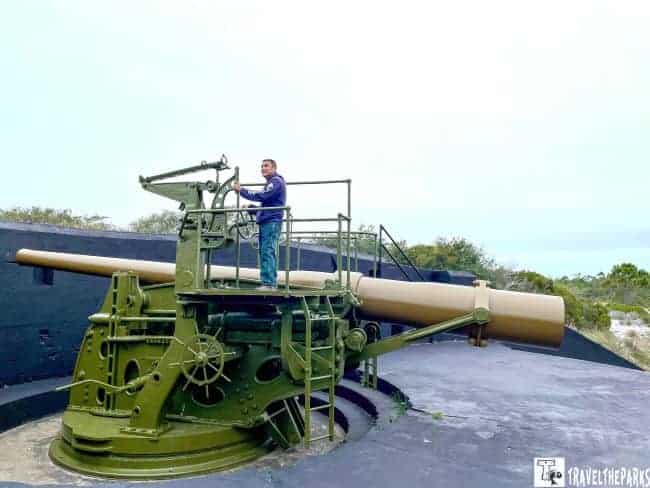
Later, for the defenses of the Fort in World War II, Batteries 234 and Cooper were constructed. Both are easily accessible from the road. They were each outfitted with disappearing guns. These were a game-changer. Mounted on hydraulic carriages, they could recoil below the parapet after firing, making them less visible to enemy ships and offering increased protection. Battery 234 sported two massive 6-inch shielded guns designed to defend against naval attacks. While the guns were never fired in combat, their imposing presence remains a testament to the fort’s wartime role.
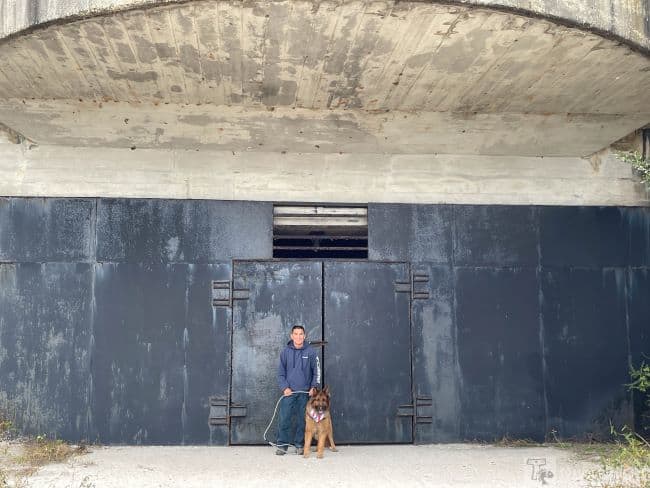
Exploring History in Stone: Battery Langdon at Fort Pickens
We climb to the top of Battery Langdon, the highest point in the park. Below us it was strategically fortified with tremendous guns during World War II, conceals its massive artillery beneath protective bunkers. The weaponry housed here represented the cutting-edge advancements of its time. With our dog, Sage in tow, we soak in the breath-taking views of the Gulf of Mexico and Pensacola Bay. Unfortunately, the churning surf generated by an offshore storm renders the search for playful dolphins in the waves futile today. Nonetheless, I find solace in appreciating the captivating beauty of the landscape that surrounds us.
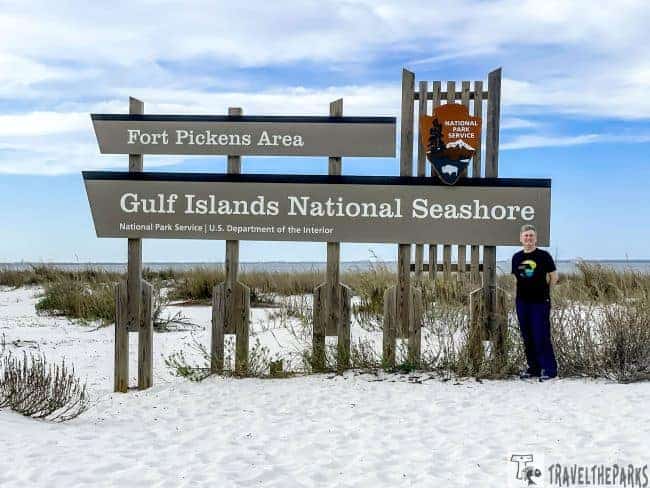
Final Thoughts-Fort Pickens Self-Guided Tour
The self-guided tour provided us with an engaging yet educational experience. As we walked through the gates of Fort Pickens, it felt like stepping back in time. Off season, we practically had the well-preserved fort to ourselves. The fort is strategic layout makes it easy to follow the self-guided stops. You will become immediately immersed in the military history of the 19th century. From the imposing walls to the many cannons placed to guard against potential invaders, every corner spoke of a bygone era. As we concluded our self-guided tour, I couldn’t help but reflect on the layers of history Fort Pickens encapsulates. The Fort is only one aspect of this national seashore. There is more to see, including the beach, the nature trails that make this a must see destination.
Have you visited Fort Pickens in the Gulf Islands National Seashore? What surprised you most about the fort? What resonated with you the most deeply?

